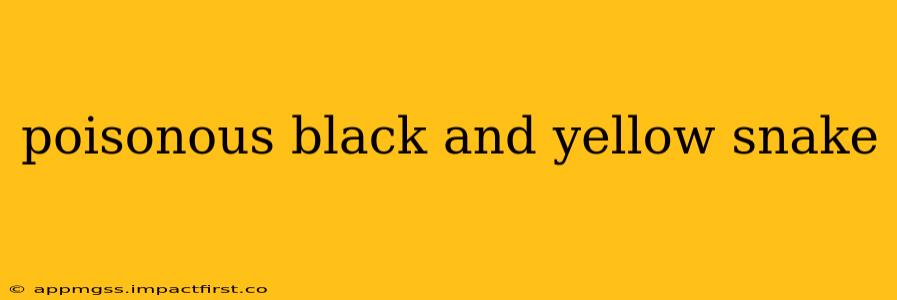Many snakes boast a striking black and yellow pattern, but not all are venomous. This color combination is a warning signal in nature, often indicating toxicity. However, it's crucial to accurately identify a snake before making assumptions about its venomous nature. This article will explore various black and yellow snakes, highlighting venomous and non-venomous species, and address common questions surrounding their identification and dangers.
What are some black and yellow snakes?
Several snake species exhibit a black and yellow pattern, varying in intensity and arrangement. Some common examples include:
-
Eastern Yellow-bellied Racer ( Coluber constrictor flaviventris): This non-venomous snake is often mistaken for a venomous species due to its vibrant yellow belly and black back. Its pattern can sometimes appear as alternating black and yellow bands.
-
Yellow-bellied Sea Snake (Pelamis platura): This highly venomous species is found in tropical waters of the Pacific and Indian Oceans. It displays a characteristic black and yellow banding pattern across its body.
-
Banded Coral Snake (Micrurus species): Several coral snake species feature striking red, yellow, and black bands. These are highly venomous snakes, and misidentification can be dangerous. Remember the rhyme: "Red on yellow, kill a fellow; red on black, venom lack." This is a helpful mnemonic, but it's not foolproof and should not be the sole basis for identification.
-
Various other species: Many other snakes, regionally specific, might display black and yellow patterns, sometimes as a faint suggestion or in juveniles. Precise identification requires careful observation and ideally, expert consultation.
Is a black and yellow snake poisonous?
The terms "poisonous" and "venomous" are often used interchangeably, but they have distinct meanings. Poisonous animals cause harm through contact (e.g., toxins in their skin), while venomous animals inject toxins through a bite or sting. Many black and yellow snakes are venomous, meaning they inject venom through their fangs. However, not all black and yellow snakes are venomous; many are harmless constrictors or possess milder venom that poses minimal threat to humans.
How can I tell if a black and yellow snake is venomous?
Accurate identification is vital. Relying solely on color is dangerous. Consider these factors:
-
Geographic location: Knowing your location helps narrow down potential species. A snake found in Florida might be different from one found in California.
-
Pattern details: While a black and yellow pattern is a starting point, examining the banding or spot pattern is crucial. Are the bands wide or narrow? Are they distinct or blurry?
-
Body shape and size: Some snakes are slender, while others are more robust. The size can also be a clue.
-
Head shape: Venomous snakes often have triangular heads, but this isn't always reliable.
-
Expert consultation: When in doubt, contact a local herpetologist, wildlife agency, or animal control for assistance. Never attempt to handle a snake you suspect is venomous.
What should I do if I see a black and yellow snake?
-
Observe from a safe distance: Admire the snake from afar, avoiding any attempt to approach or interact with it.
-
Do not attempt to handle it: Even non-venomous snakes can bite if threatened.
-
Keep children and pets away: Ensure that children and pets maintain a safe distance.
-
Document the sighting (if safe to do so): Take a photograph from a safe distance (with your phone's zoom) to aid in identification if necessary.
-
Contact local wildlife experts: If you are concerned about the snake's presence or believe it might pose a danger, contact your local wildlife agency or animal control.
What type of venom do black and yellow snakes have?
The type of venom varies greatly depending on the species. Some black and yellow snakes, like the banded coral snake, have potent neurotoxic venom, which affects the nervous system. Others might have milder hemotoxic venom, affecting the blood. The severity of a bite depends on the species, the amount of venom injected, and the victim's health.
Remember: This information is for educational purposes only and should not be considered a substitute for professional guidance. Always prioritize safety and consult experts when dealing with potentially venomous snakes.
